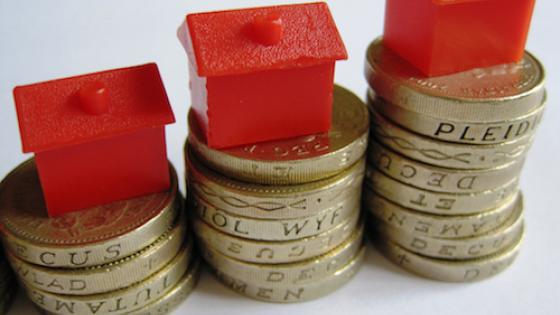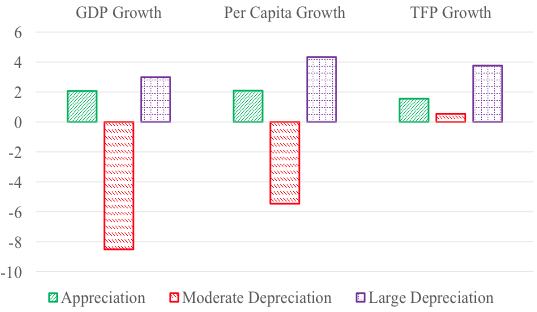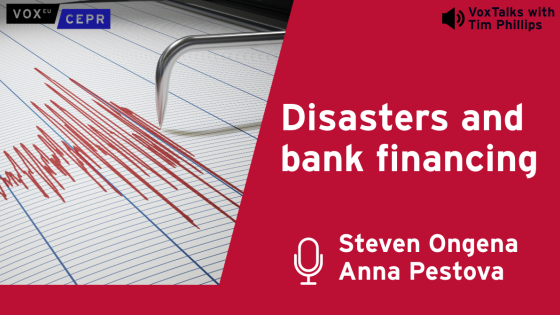Rising housing prices are accompanied by higher household consumption and firm investment that boost economic growth. However, excessive house price appreciations may distort capital allocation efficiency, for example by crowding out investments in productive sectors, which reduce long-term economic growth. Moreover, house price bubbles are typically unsustainable. Once a housing bubble bursts, credit conditions will tighten due to falling collateral value, leading to a fall in household consumption and employment that cause an economic downturn. Meanwhile, the correction of housing prices may improve investment efficiency and trigger structural reform that subsequently enhances economic growth.
In recent work, we look into the trade-off between the aforementioned effects and document new international evidence on the relation between real estate valuations at different stages of housing cycles and economic growth (Aizenman et al. 2016).
Appreciations versus depreciations
Figure 1 shows that appreciations of housing prices can be translated into higher growth in real GDP, real GDP per capita and total factor productivity (TFP). This positive relation between house price appreciations and economic growth remain robust, even after filtering the economic growth attributed to the increase in consumption, investment, employment, and credit allocation that partially benefit from rising house prices. In particular, a 10% increase in house price appreciation is associated with 0.2% higher economic growth. Accounting for the indirect effect of house price through consumption, investment and employment further strengthen the association between house appreciations and economic growth.
Figure 1. Summary of associations with growth
Notes: The graph plots the association of 1% increase in house price appreciation, moderate house price depreciation, and large house price depreciation with GDP growth, GDP per capita growth, and total factor productivity (TFP) growth in basis points.
The relation between house depreciations and economic growth, however, are nonlinear, depending on the depth and speed of price correction. Moderate house price depreciations, characterised by a modest, prolonged decline in house prices, are negatively associated with economic growth in real GDP and GDP per capita. However large depreciations, characterised by a sharp and quick drop in house prices, are positively associated with stronger growth in economic output and productivity. This result is consistent with the finding of Mian et al. (2015) that large and moderate house price depreciations have asymmetric impacts on economic activity in the US.
While large house price depreciations are associated with lower levels of consumption, investment, and employment that undermine economic growth, it can trigger capital allocation efficiency and labour mobility that benefits growth. First of all, credit is reallocated to more efficient firms after a crisis (Borensztein and Lee 2002). Second, steep housing price corrections force zombie firms out of the market, which allows banks to lend more efficiently than committing loans to unproductive zombie firms (Caballero et al. 2008). Third, large depreciations increase the number and magnitude of underwater mortgages, which enhance labour mobility because underwater mortgages provide greater incentive for households to relocate from a relatively poor to a better labour market (Donovan and Schnure 2011, Schulhofer-Wohl 2011). The increase in labour matching contributes to the economic growth. These improvements in capital allocation efficiency and labour mobility are less likely to happen when the price declines moderately as it is not sufficient to trigger a structural change that change existing norms.
Cross-country difference
In the presence of banking crisis, there is no longer a positive relation between large house depreciations and economic growth. The benefit of economic growth is wiped out when large house appreciations disrupt the banking sector, which prevents it from allocating capital efficiently. In this case, the housing cycles can be quite costly.
The strength of the linkage between large house price depreciations and economic output growth varies across legal systems, and subject to the availability of mortgage insurance and personal bankruptcy law. In countries with a stronger safety net provided through mortgage insurance and personal bankruptcy law, the consequence of large house depreciations is less severe, which is less likely to trigger significant structural changes that motivate reshuffles in capital and the labour market.
Housing cycles and economic growth
The average duration of housing appreciations and depreciations in a typical housing cycle is approximately six and five years, respectively (Bracke 2013). So the housing market would appreciate by 5.4% per year (the sample mean in appreciations) for the first six years, and then depreciate by 3.2% per year (sample mean in depreciations) in the five years that follow. Figure 2 visualises the total contribution of a typical housing cycle to GDP growth in each country. There are significant variations across countries. Such a relation is the strongest in Hong Kong – in the absence of housing price cycles, the economic growth in Hong Kong would have been lower by 67 basis points per year. Cumulated over several years this can have a significant impact on long-term economic growth. On average, the housing price cycles add 26–35 basis points to economic growth annually. Given our sample periods, the contribution of housing valuations to economic growth is negative in Germany and Japan, although the magnitudes are relatively small.
Figure 2. Average contribution of housing cycles to GDP growth (%)
Notes: Housing cycles are shown to contribute positively to GDP growth in 17 out of 19 countries studied, with Japan and Germany being the two exceptions.
Conclusion
Although house price appreciations are positively associated with output growth, house price depreciations may either undermine or stimulate growth, depending on the depth of correction and the market environment. Large house price depreciations are associated with strong recovery in growth in the absence of banking crises, and this association is stronger in countries with a relatively weak safety net. These results are consistent with the conjecture that delaying needed adjustment associated with realising large capital losses is associated with deeper stagnation. In these circumstances, faster realisation of losses combined with income support that deals with poverty mitigation may be superior to the stagnation that is associated with such ‘gambling for resurrection’ adjustment delays. More research is needed to clarify the magnitude of these tradeoffs.
Reference
Aizenman, J, Y Jinjarak and H Zheng (2016) "House valuations and economic growth: Some international evidence", NBER, Working Paper No 22699.
Bracke, P (2013) "How long do housing cycles last? A duration analysis for 19 OECD countries", Journal of Housing Economics, 22(3): 213-30.
Borensztein, E and J–W Lee (2002) "Financial crisis and credit crunch in Korea: Evidence from firm-level data", Journal of Monetary Economics, 49: 853-875.
Caballero, R J, T Hoshi and A K Kashyap (2008) "Zombie lending and depressed restructuring in Japan", The American Economic Review, 98(5): 1943-1977.
Donovan, C and C Schnure (2011) "Locked in the house: Do underwater mortgages reduce labor market mobility?".
Mian, A, A Sufi and F Trebbi (2015) "Foreclosures, house prices, and the real economy", The Journal of Finance, 70(6): 2587-634.
Schulhofer-Wohl, S (2011) "Negative equity does not reduce homeowners' mobility", NBER, Working Paper No 16701.









